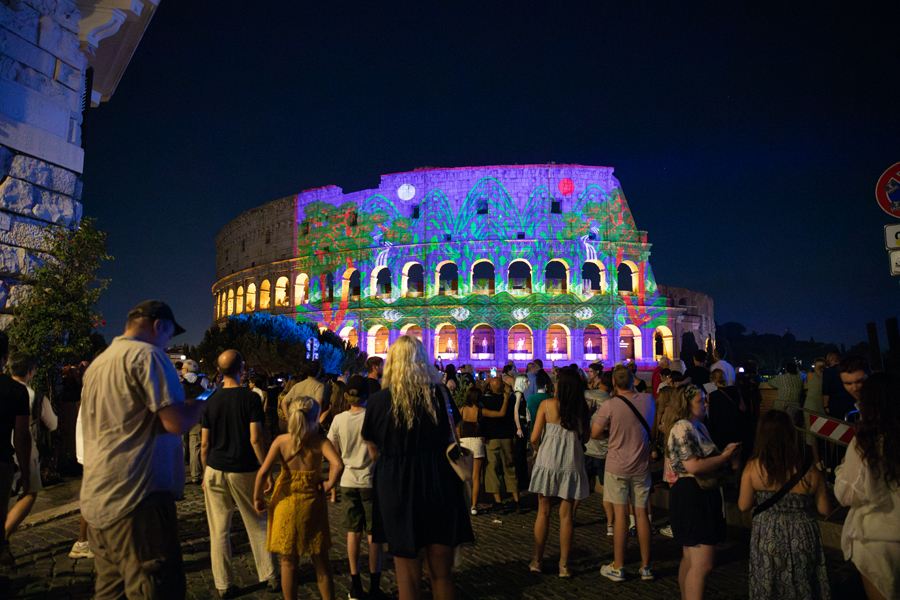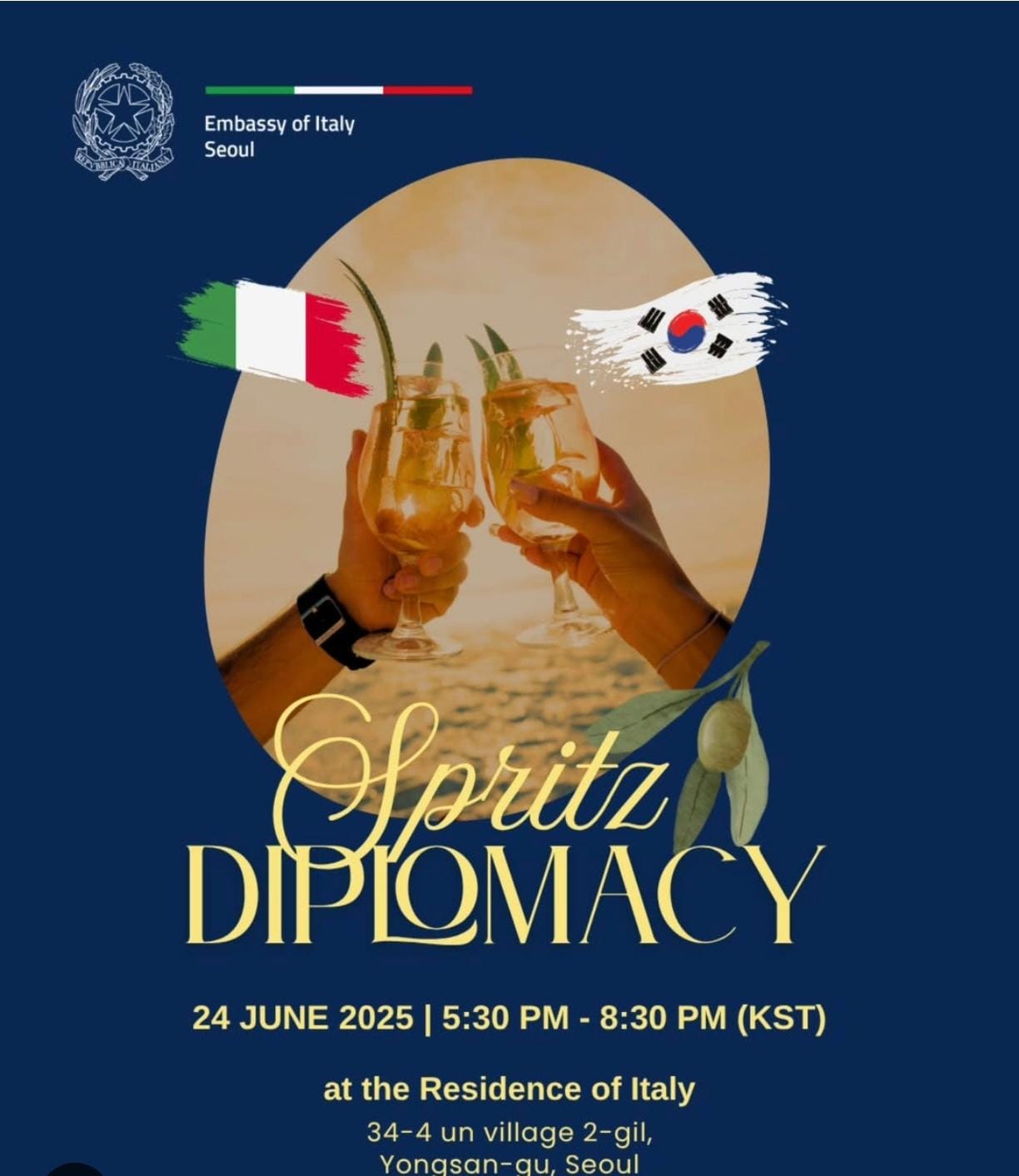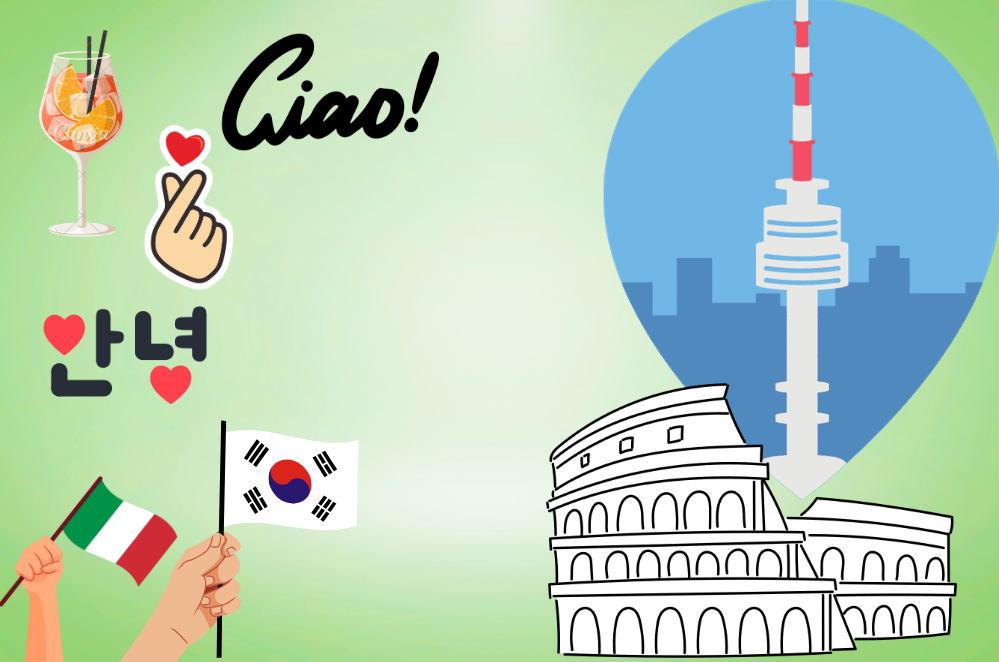Art, aperitivo, and dialogue: Italy and Korea celebrate cultural diplomacy in 2024–2025.
2025-07-01The Colosseum lights up to celebrate the Italy-Korea Cultural Exchange Year 2024-2025
A spectacular projection transforms the Roman amphitheater into a symbol of international dialogue. A historic evening unfolded on June 26, 2025, when the Colosseum was transformed for the first time into an extraordinary luminous canvas to celebrate the Italy-Korea Cultural Exchange Year 2024–2025. At 9 PM, the facade of the iconic Roman monument came alive with a captivating media facade projection, showcasing the rich cultural and historical heritage of both nations. The result was a deeply moving and symbolic visual experience for both citizens and visitors alike.
The event, organized by the Ministry of Culture, Sports and Tourism of the Republic of Korea, led by Minister Yu In Chon, marked a significant milestone in the diplomatic relations between the two countries. The projection, realized in collaboration with the Korean Cultural Institute in Italy (directed by Kim Nury) and the Korea Foundation for International Cultural Exchange (KOFICE) (chaired by Park Chang Sik), alongside the Municipality of Rome and the Colosseum Archaeological Park, represented the first initiative of its kind ever undertaken by the Korean government at the Roman amphitheater.
No venue could have been more fitting or evocative for such a unique and symbolic celebration.
The video content production brought together an exceptional international artistic team. Korean artist Lee Lee-nam, renowned for blending traditional art with contemporary technology, collaborated with the Italian collective Squatters Lab, artist Vincenzo Marsiglia, and the Korea Round team, composed of young creatives from both countries. This creative synergy gave life to a visual masterpiece that masterfully fused tradition and innovation, building a vibrant bridge between Italy and Korea through the universal language of art.
The celebration was held at Caffè Roma, near the Colosseum, in the presence of around seventy distinguished guests, including You Heung-sik, Prefect of the Dicastery for the Clergy, and Alfonsina Russo, Director of the Colosseum Archaeological Park.
This event served as an extraordinary platform to foster constructive dialogue and collaboration among various cultural and religious institutions, paving the way for new perspectives in international cooperation and laying fertile ground for future joint initiatives.
This initiative is part of the broader Italy–Korea Cultural Exchange Year 2024–2025, which celebrates the long-standing diplomatic ties between the two countries. The choice of the Colosseum—a universal symbol of history and culture—as the backdrop for this projection was anything but accidental: the Roman amphitheater became the stage for a new chapter in global relations, where art and technology converge to build bridges of mutual understanding.
The event of June 26, 2025, will be remembered as a moment of extraordinary beauty and cultural significance, a shining example of how cultural diplomacy can transform historic monuments into living symbols of international dialogue.
The projection on the Colosseum was more than a visual spectacle; it was a message of peace and collaboration, illuminating one of the Seven Wonders of the Modern World and turning it, for one unforgettable night, into a beacon of friendship between Italy and Korea.
The success of the event also demonstrated the power of contemporary digital storytelling in building cultural bridges. More than just a light show, the projection wove a narrative that resonated deeply with viewers, connecting the ancient legacies of two civilizations through the lens of cutting-edge technology and shared creativity.

N.B: The images used in this article have been kindly provided by the Korean Cultural Institute, with prior authorization and permission to use them for informational purposes, in accordance with the established guidelines and terms of use. Image credits are attributed to the Korean Cultural Institute in Italy, as indicated in the 'Event Photos' section on their website.
Alongside the projection event, a special celebratory gathering was held near the Colosseum, bringing together around 70 distinguished guests to mark the launch of the Italy-Korea Cultural Exchange Year 2024–2025. Among those in attendance were leading artists from both countries, the Minister Plenipotentiary and Consul General of the Embassy of the Republic of Korea in Italy, Kim Gun Hwa, as well as high-level representatives from the Italian Ministry of Culture and the Ministry of Foreign Affairs and International Cooperation. The evening served as a vibrant moment of cross-cultural dialogue and artistic recognition. During the event, the featured artists took the stage to present their creative visions and explain the inspiration behind their contributions to the media facade projection. A dedicated press session followed, offering journalists and cultural correspondents the opportunity to engage directly with the artists and organizers. The atmosphere combined the prestige of diplomatic ceremony with the dynamism of contemporary art, underscoring the shared commitment of Italy and Korea to fostering long-term cultural collaboration through innovative and accessible formats.
Yoon Yang-soo, Director-General of the Bureau of International Cultural Affairs and Public Relations at the Ministry of Culture, Sports and Tourism of the Republic of Korea, stated: “This media facade projection, which brought together Korean and Italian art and technology at the Colosseum, a World Cultural Heritage site, is a meaningful achievement that demonstrates new possibilities for cultural exchange between the two countries.”
He added: “I hope that, on the occasion of the Year of Cultural Exchange, young artists from both countries will engage in more active communication and that cultural cooperation will continue over time.”
(The statement was taken from the official press release of the event, kindly provided with permission by the Korean Cultural Institute in Italy).
Spritz Diplomacy: A Friendly Aperitivo on Dynamic Geopolitical Trends
The Residence of the Italian Embassy in Seoul has inaugurated a new era of diplomatic dialogue with the launch of "Spritz Diplomacy: A Friendly Aperitivo on Dynamic Geopolitical Trends" an innovative informal platform that combines the elegance of Italian aperitivo culture with the depth of contemporary geopolitical analysis. The name "Spritz Diplomacy" is not coincidental: the spritz, an iconic Italian cocktail made with prosecco, aperol, and sparkling water, perfectly symbolizes the initiative's approach - a balanced mix of different elements that combine to create something unique and enjoyable, much like the diplomatic dialogue that blends Italian tradition, international expertise, and informal yet substantial discussion.

The initiative, promoted by Ambassador Emilia Gatto, represents a revolutionary approach to public diplomacy, transforming the traditional conference format into a more accessible and engaging dialogue experience. The first episode, dedicated to Italian and Korean diplomatic initiatives in the Indo-Pacific, featured an international panel of excellence moderated by Giulia Pompili, correspondent for East Asia at the Italian daily Il Foglio and Indo-Pacific specialist with over a decade of experience in Asian journalism. Among the prestigious speakers, CHOI Young Joon from the Institute for Far Eastern Studies and former Vice Minister of Unification brought his direct experience in inter-Korean issues and regional security dynamics, while CHA Du Hyeogn from the Asan Institute for Policy Studies contributed with in-depth analyses on Korean security policies. The Italian perspective was represented by Aurelio Insisa from the Institute of International Affairs, who illustrated Italian strategies in the Indo-Pacific, and by Giulio Pugliese from King's College London, who enriched the debate with comparative analyses and advanced theoretical perspectives. The discussion, conducted under the prestigious Chatham House Rule that ensures greater freedom of expression for participants, benefited from simultaneous interpretation to ensure fluid and inclusive communication. The event achieved extraordinary success, generating lively debate during the Q&A session and fostering the initiation of new collaborations between Italian and Korean academic institutions and research centers.
This innovative format, which combines the informality of Italian tradition with the rigor of strategic analysis, emerges as an exportable model for other diplomatic representations, demonstrating how contemporary diplomacy can evolve to meet 21st-century challenges while maintaining high intellectual content quality. Ambassador Gatto's initiative, known for her focus on people-to-people diplomacy and space technology cooperation with Korea, represents a virtuous example of how Italy can position itself as a facilitator of international dialogue in the Asia-Pacific area, consolidating bilateral relations through an approach that prioritizes intellectual engagement and the construction of lasting collaborative networks.
Photo credit: Embassy of Italy in Seoul.
The Italy-Korea Cultural Exchange Year 2024-2025 represents a transformative moment in contemporary diplomacy. This period has witnessed the emergence of innovative diplomatic practices that transcend conventional boundaries, utilizing art, heritage, and informal dialogue as vehicles for deeper mutual understanding.
The spectacular multimedia projection that transformed Rome's Colosseum into a canvas for Korean traditional art represents far more than a simple cultural exhibition.
The Colosseum, a monument that has stood for nearly two thousand years as a testament to Roman engineering and cultural achievement, became a temporary home for Korean artistic expression. This transformation served multiple diplomatic functions: it honored Korea's rich cultural heritage while demonstrating Italy's openness to embracing and celebrating foreign traditions. The visual impact created a shared space where Italian and Korean identities could coexist and interact.
Furthermore, the choice of venue speaks to the democratizing nature of cultural diplomacy. Unlike closed diplomatic meetings or exclusive cultural events, the Colosseum projection was accessible to all tourists, Romans, international visitors, and digital audiences worldwide. This accessibility transformed every observer into a participant in the diplomatic exchange, creating thousands of personal connections to the Italy-Korea relationship that extend far beyond official government channels.
The "Spritz Diplomacy" series launched in Seoul represents an equally revolutionary approach to international relations discourse, albeit through a completely different medium.
The genius of Spritz Diplomacy lies in its recognition that the most profound insights often emerge from informal exchanges rather than formal presentations. The format acknowledges that drinks, conversation, and relaxed atmospheres can facilitate more honest, creative, and productive discussions about complex international issues. Participants are encouraged to think more freely, challenge conventional wisdom, and explore nuanced perspectives that might be suppressed in more formal diplomatic settings.
This approach also reflects a broader trend toward humanizing international relations. The informal setting creates space for empathy, humor, and genuine curiosity—elements that are often absent from traditional diplomatic encounters but essential for lasting international cooperation.

While the Colosseum projection and Spritz Diplomacy appear to operate in completely different spheres—one public and spectacular, the other intimate and conversational—they represent complementary facets of a comprehensive cultural diplomacy strategy. The projection creates broad public awareness and emotional connection, while Spritz Diplomacy fosters deeper intellectual engagement and personal relationships among thought leaders, policy makers, and cultural influencers.
The projection serves as a powerful tool for what might be called "soft power projection"—it creates positive associations, generates media coverage, and builds general goodwill toward the Italy-Korea relationship. Its visual impact ensures that the message reaches diverse audiences across cultural, linguistic, and educational boundaries. The event becomes a shared reference point that both Italians and Koreans can point to as evidence of their countries' friendship and mutual respect.
Spritz Diplomacy, by contrast, operates in the realm of "deep diplomacy"—it builds the intellectual and personal foundations that sustain long-term international cooperation. The conversations generated through these events create networks of understanding that extend far beyond the immediate participants. Ideas developed in Seoul's informal settings may influence policy discussions, academic research, business partnerships, and cultural collaborations for years to come.
Italy's willingness to transform its most iconic monument into a showcase for Korean culture represents a significant gesture of respect and friendship. Similarly, Korea's engagement with Italian intellectual and social traditions through Spritz Diplomacy shows a reciprocal appreciation for Italian approaches to discourse and relationship-building.
Both initiatives show how cultural diplomacy can incorporate modern technologies, social media, and contemporary communication strategies while maintaining authentic connections to historical traditions. The projection utilized cutting-edge projection technology to honor centuries-old Korean artistic techniques. Spritz Diplomacy employs social media documentation and international networking to extend the reach of traditional Italian conversational culture.
The success of these initiatives, engaging diverse populations through art, dialogue, and shared experiences, creates multiple points of connection between societies.
In a world searching for new forms of connection and understanding, these luminous milestones illuminate a path toward more meaningful, sustainable, and joyful international relations.
The legacy of these initiatives extends far beyond their immediate impact. They establish precedents for how nations can celebrate their differences while building bridges of understanding, how technology can serve humanity's oldest artistic traditions, and how informal dialogue can address the most serious global challenges. Most importantly, they demonstrate that diplomacy, at its best, is not merely about managing differences between nations, but about discovering and celebrating the common humanity that unites us all.
How about this article?
- Like0
- Support0
- Amazing0
- Sad0
- Curious0
- Insightful0


